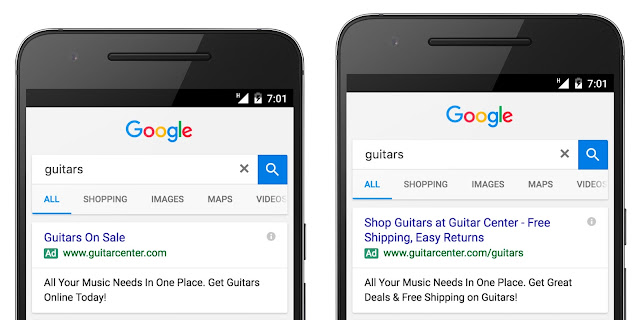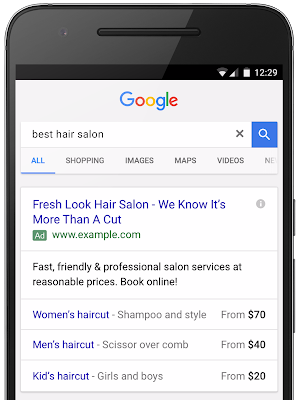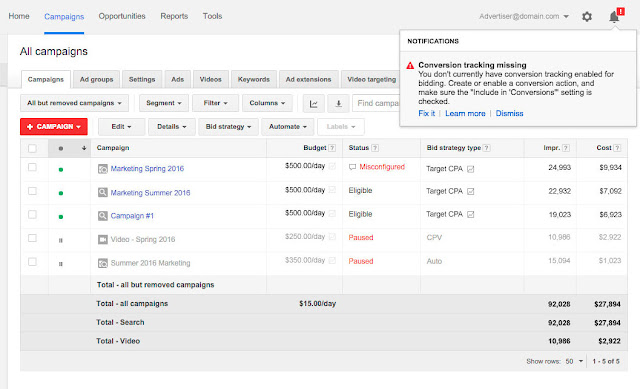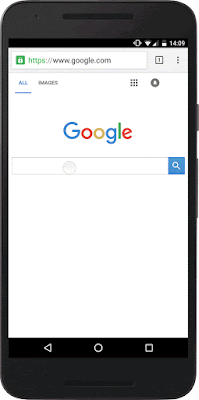Starting today, these innovations will begin rolling out in AdWords to all advertisers around the world.
Get started with expanded text ads Earlier this year, we removed right-hand side ads to improve the search experience and make it consistent across mobile, desktop, and tablet. This helped pave the way for the biggest update to our ad creative since we introduced AdWords more than 15 years ago.
Expanded text ads are optimized for the screen sizes of the most popular smartphones and feature two headlines, each with 30 characters, and one long 80-character description line. That’s nearly 50% more ad text for you to highlight your products and services.
 | |
| Standard text ad | Expanded text ad |
Our research shows longer ad headlines are more useful to mobile users because they provide additional information about your business before they click your ad. In fact, here are some early success stories from advertisers who have started using expanded text ads:
It’s important for advertisers to take advantage of expanded text ads as soon as possible, especially with back to school and the holiday season right around the corner. To help you get started, we’ve published a best practices guide that walks through tips and tricks for creating and optimizing expanded text ads. Specifically:
AdWords Editor and the AdWords API also support expanded text ads, which means you can create and edit your ads in bulk to help save time. If you use leading 3rd-party tools to manage your ads, DoubleClick Search, Kenshoo, and Marin Software all support expanded text ads as well.Starting on October 26th, 2016, you’ll no longer be able to create or edit standard text ads — meaning you’ll only be able to create and edit text ads using the expanded text ads format after this date. Existing standard text ads will continue to serve alongside expanded text ads.
Create responsive ads for display
In a mobile-first world, display ads need to fit seamlessly within the websites and apps people visit, while delivering a consistent experience across devices. We built responsive ads for display to help your ads adapt to the increasingly diverse mix of content types and screen sizes. Provide 25-character and 90-character headlines, a 90-character description, an image, and a URL, and Google designs ads that fit beautifully across more than two million apps and websites on the Google Display Network (GDN). Responsive ads also unlock new native inventory so you can engage consumers with ads that match the look and feel of the website or app they’re using.
Set device bid adjustments
As we re-imagine how ads look in a mobile-first world, it’s also important to have more flexible tools that help you optimize device-level performance. New device bid adjustments allow you to maintain the efficiency of managing a consolidated campaign that reaches consumers across devices while giving you more control to set individual bid adjustments for each device type — mobile devices, computers, and tablets. Our updated best practices guide can help you evaluate your bidding strategy and set accurate performance targets that reflect the full value of mobile. You can also join us for a Hangout on Air at 9am PDT/12pm EDT on August 9th, 2016 for a live Q&A about device bid adjustments with Google product experts. Register here.
While device bid adjustments enable you to optimize with greater precision, you still need to factor in other signals which impact performance, like location, time of day, and audience. To optimize at scale across this wide range of contextual signals, you should take advantage of automated bidding. Smart Bidding utilizes the power of Google’s machine learning to set more informed bids and help you get the most out of your marketing budget. The latest Smart Bidding innovations are available in both AdWords and DoubleClick Search. In the coming weeks, you’ll also be able to set device-specific CPA goals with Target CPA Smart Bidding in AdWords.The way consumers use technology to connect with the world around them has changed. As a result, we’ve re-designed AdWords, from ad formats to bidding, to help you reach potential customers in more meaningful and relevant ways. We’re excited to undertake this journey with you and look forward to hearing your feedback.























